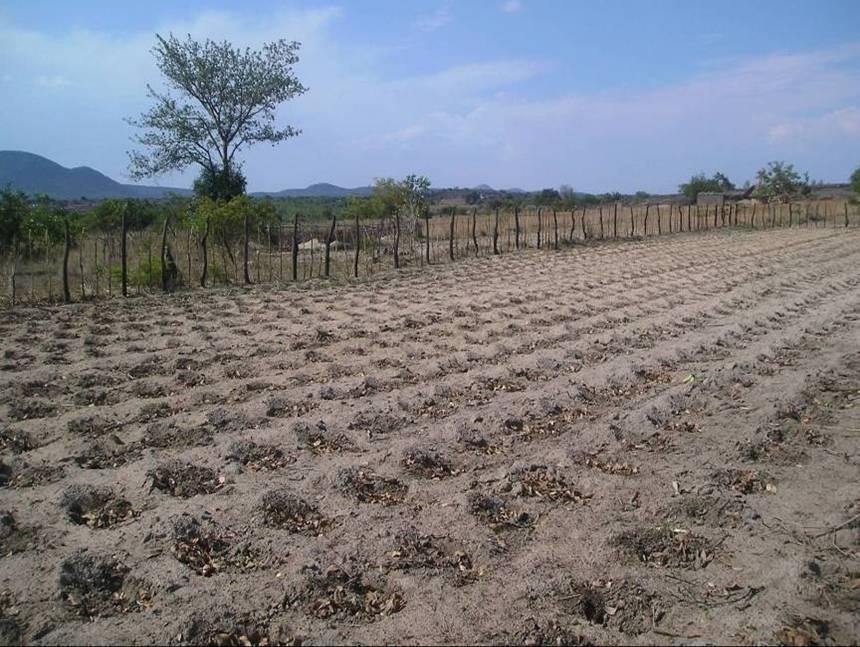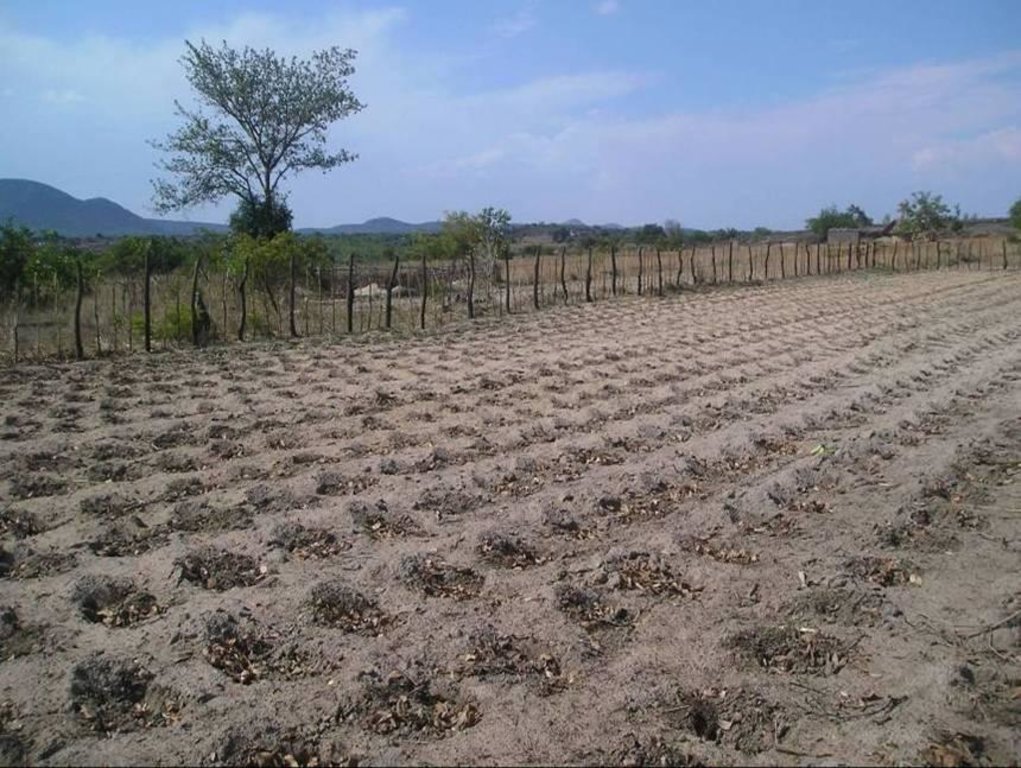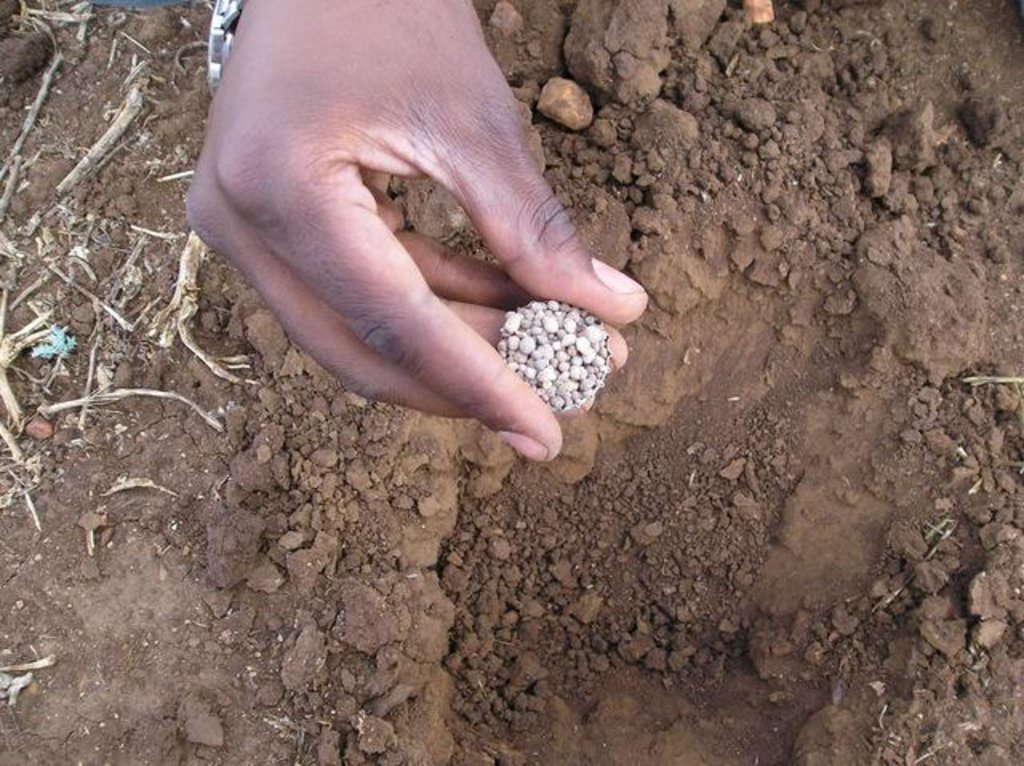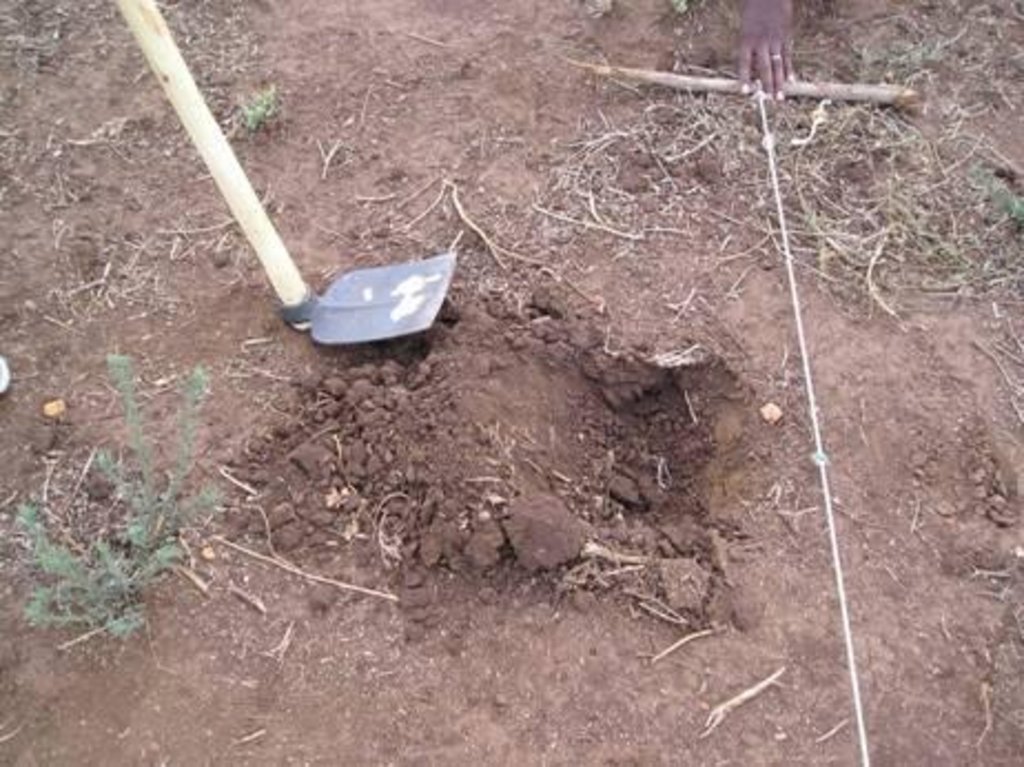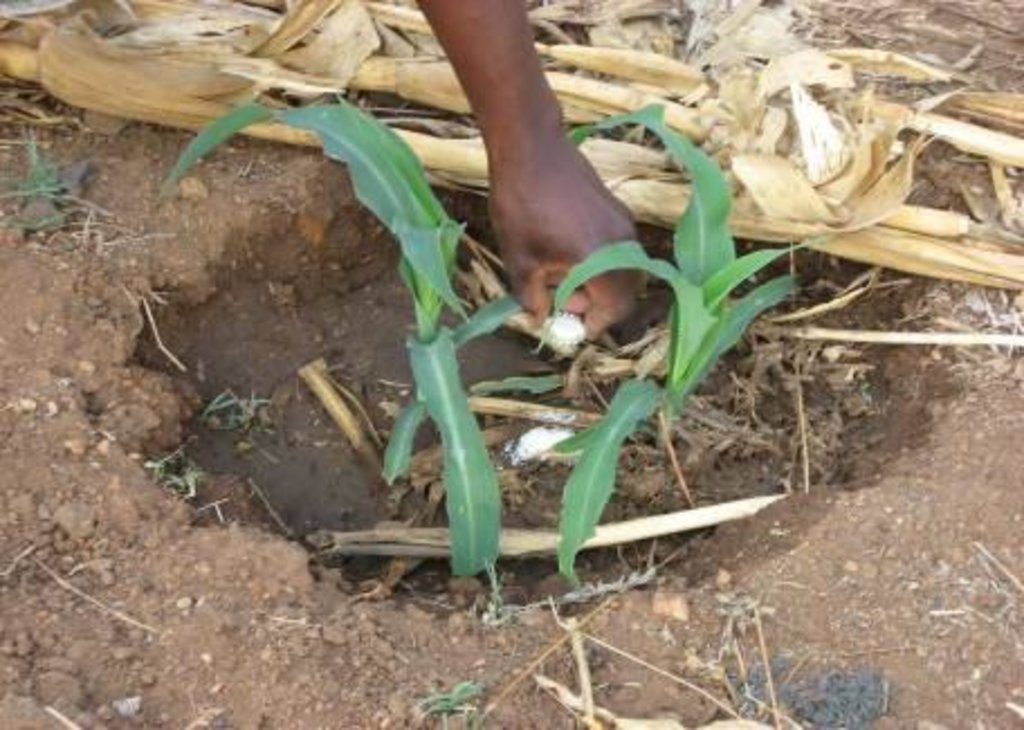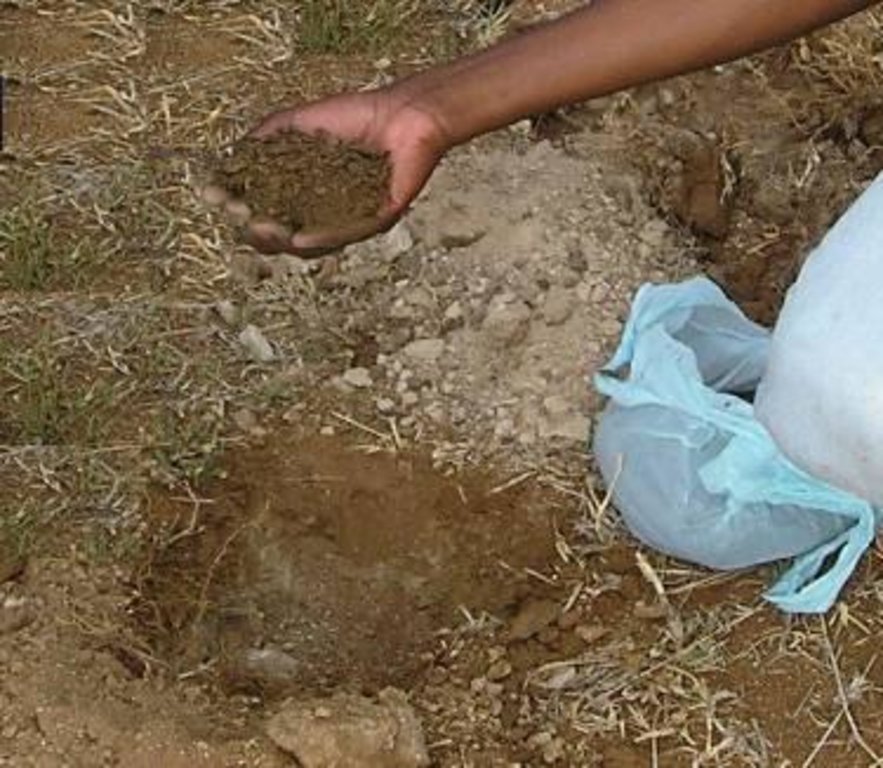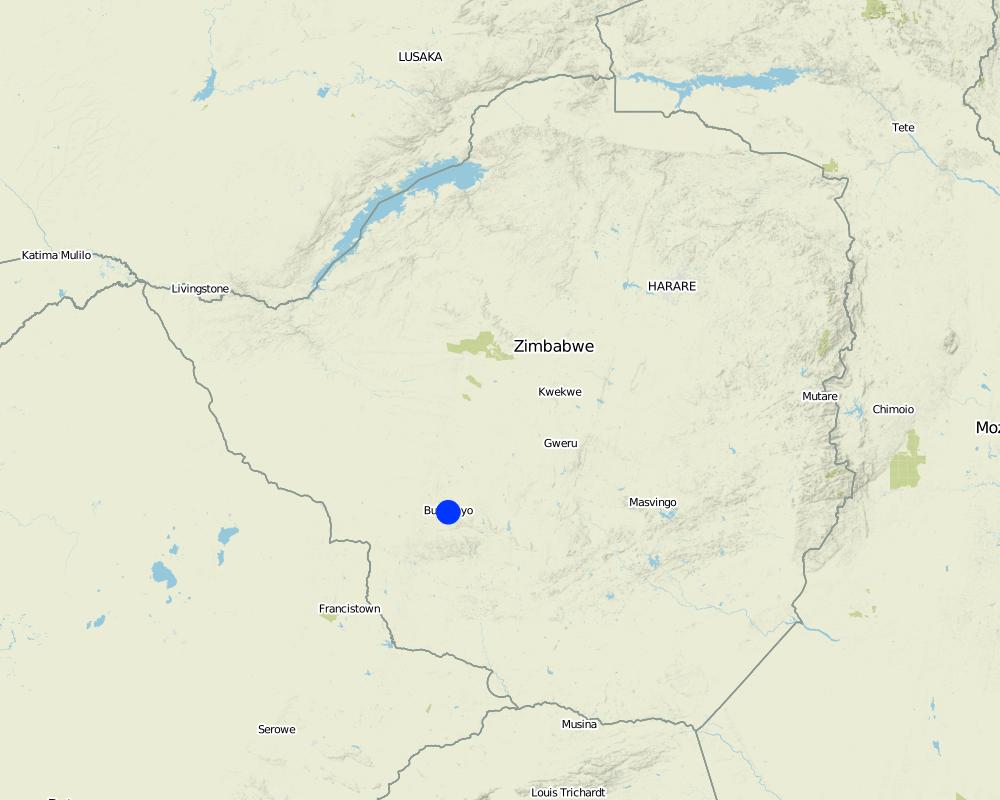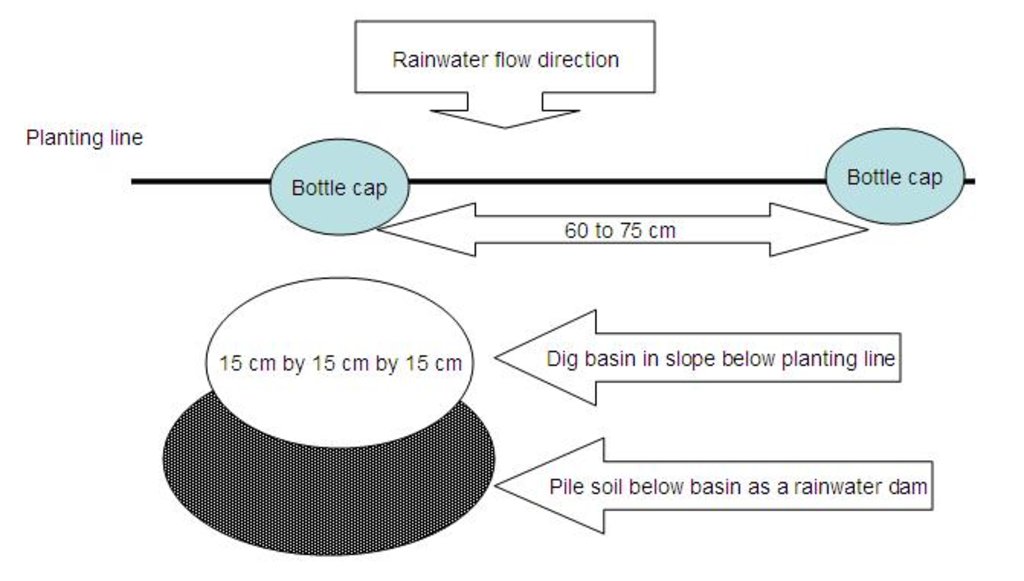Precision Conservation Agriculture [Zimbábue]
- Criação:
- Atualização:
- Compilador/a: Stephen Twomlow
- Editor: –
- Revisores: Deborah Niggli, Alexandra Gavilano
technologies_1327 - Zimbábue
Veja as seções
Expandir tudo Recolher tudo1. Informação geral
1.2 Detalhes do contato das pessoas capacitadas e instituições envolvidas na avaliação e documentação da tecnologia
Nome do projeto que facilitou a documentação/avaliação da Tecnologia (se relevante)
Book project: SLM in Practice - Guidelines and Best Practices for Sub-Saharan Africa (SLM in Practice)1.3 Condições em relação ao uso da informação documentada através de WOCAT
O/a compilador/a e a(s) pessoa(s) capacitada(s) aceitam as condições relativas ao uso de dados documentados através da WOCAT:
Sim
1.4 Declaração de sustentabilidade da tecnologia descrita
A tecnologia descrita aqui é problemática em relação a degradação da terra de forma que não pode ser declarada uma tecnologia de gestão sustentável de terra?
Não
2. Descrição da tecnologia de GST
2.1 Descrição curta da tecnologia
Definição da tecnologia:
Precision Conservation Agriculture combines aspects of conservation agriculture and precision application of fertilizer.
2.2 Descrição detalhada da tecnologia
Descrição:
Precision Conservation Agriculture (PCA) is a combined technology that encompasses four basic principles: 1) minimum tillage – e.g. using planting basins which enhance the capture of water from the first rains and allow efficient application of limited nutrient resources with limited labor input; 2) the precision application of small doses of nitrogen-based fertilizer to achieve higher nutrient efficiency (from organic and/or inorganic sources); 3) combining improved fertility with improved seed for higher productivity; and 4) use of available residues to create a mulch cover that reduces evaporation losses and weed growth. Crop mixes are adapted to the local conditions and household resource constraints. Cereal/legume rotations are desirable. PCA spreads labor for land preparation over the dry seasons and encourages more timely planting, resulting in a reduction of peak labor loads at planting, higher productivity and incomes. Over four years these simple technologies have consistently increased average yields by 50 to 200% in more than 50,000 farm households. These strategies are promoted by ICRISAT, FAO and NGOs in Southern Africa focusing on low potential zones where most of the most resource-poor and vulnerable farm households exist.
Components of CF Planting Basins Package promoted in Zimbabwe:
1. Winter weeding: The first step in preparing a field using CF methods is to remove all weeds. This should be done soon after harvesting in May/June. Weeding is done using implements such as hand hoes and machetes that disturb the soil as little as possible. The importance of weeding before land preparation is to ensure that the plot is weed-free at basin preparation and also to prevent the dispersal of weed seeds.
2. Digging planting basins: Planting basins are holes dug in a weed-free field into which a crop is planted. The basins are prepared in the dry season from July to October. The recommended dimensions of the basin are 15×15×15 cm, spaced at either 75×60 cm for rainfalls of 650 to 900 mm and either 75x75 cm or 90×60 cm for Natural rainfalls of 400 to 650 mm. The basins enable the farmer to plant the crop after the first effective rains when the basins have captured rainwater and drained naturally. Seeds are placed in each basin at the appropriate seeding rate and covered with clod-free soil. The advantage of using basins is that they enhance the capture of water from the first rains of the wet season and enable precision application of both organic and inorganic fertilizer as it is applied directly into the pit and not broadcast.
3. Application of crop residues: Crop residues are applied on the soil surface in the dry season, soon after harvesting if available. Ideally the residues should provide at least 30% soil cover. The mulch buffers the soil against extreme temperatures (thereby reducing soil evaporation), cushions the soil against traffic, and suppresses weeds through shading and improves soil fertility.
4. Application of manure: Fertility amendments are applied soon after land preparation in the dry season. In CF, the application of both organic and inorganic fertilizers is recommended as they complement each other. Organic fertilizers such as manure and/or composts are applied at a rate of at least a handful per planting basin. More can be used in wetter areas.
5. Application of basal fertilizer: Inorganic basal fertilizer is also applied soon after land preparation before the onset of the rains. One level beer bottle cap is applied per planting basin and covered lightly with clod-free soil. This is equivalent to 80 kg of compound fertilizer per hectare. Application rates can be increased in wetter areas and may depend on crop types.
6. Application of topdressing: Nitrogen fertilizer is applied to cereal crops at the 5 to 6 leaf stage soon after the first weeding at a rate of one level beer bottle cap per basin. This is equivalent to 80 kg of ammonium nitrate fertilizer per hectare. Application is done on moist soils. Precision application ensures that the nutrients are available where they are needed. Application rates can be increased in wetter areas and may depend on crop types.
7. Timely weeding: In conventional tillage systems, farmers plough/cultivate repeatedly in order to suppress weeds. With reduced tillage, weeds can be a problem requiring more effort initially. One strategy is to weed in a timely manner (ie, when the weeds are still small) preventing the weeds from setting seed. Timely weeding in combination with mulch should eventually lead to effective weed control.
8. Crop rotation: Rotating crops is one of the key principles of CF. Cereal/legume rotations are desirable because the cereal benefits from nitrogen produced by the Rhizobium associated with the legume, and the legume benefits from the residues produced by the cereal. The advantages of crop rotation include improvement of soil fertility, controlling weeds, pests and diseases, and producing different types of outputs, which reduce the risk of total crop failure in cases of drought and disease outbreaks.
2.3 Fotos da tecnologia
2.5 País/região/locais onde a tecnologia foi aplicada e que estão cobertos nesta avaliação
País:
Zimbábue
Especificação adicional de localização:
Bulawayo
Map
×2.6 Data da implementação
Caso o ano exato seja desconhecido, indique a data aproximada:
- menos de 10 anos atrás (recentemente)
2.7 Introdução da tecnologia
Especifique como a tecnologia foi introduzida:
- durante experiências/ pesquisa
3. Classificação da tecnologia de GST
3.1 Principal/principais finalidade(s) da tecnologia
- Melhora a produção
3.2 Tipo(s) atualizado(s) de uso da terra onde a tecnologia foi aplicada

Terra de cultivo
- Cultura anual
Comentários:
Major land use problems (land users’ perception): soil fertility decline and reduced organic matter, soil erosion by water, sealing and crusting
3.5 Grupo de GST ao qual pertence a tecnologia
- Gestão integrada de fertilidade do solo
3.6 Medidas de GST contendo a tecnologia

Medidas agronômicas
- A1: cobertura vegetal/do solo
- A2: Matéria orgânica/fertilidade do solo
- A3: Tratamento da superfície do solo
- A4: Tratamento do subsolo
- A5: Gestão de sementes, variedades melhoradas
- A6: Gerenciamento de resíduos
- A7: Outros
A3: Diferenciar os sistemas de lavoura:
A 3.2: Reduced tillage (> 30% soil cover)

Medidas vegetativas
- V5: Outros

Medidas estruturais
- S11: Outros

Medidas de gestão
- M1: Mudança no tipo de uso da terra
- M4: Principal mudança no calendário de atividades
3.7 Principais tipos de degradação da terra abordados pela tecnologia

Erosão do solo pela água
- Wt: Perda do solo superficial/erosão de superfície

Deteriorização química do solo
- Cn: declínio de fertilidade e teor reduzido de matéria orgânica (não causado pela erosão)

Deteriorização física do solo
- Pk: quebra e ressecamento
Comentários:
Secondary causes of degradation: soil management
3.8 Redução, prevenção ou recuperação da degradação do solo
Especifique o objetivo da tecnologia em relação a degradação da terra:
- Prevenir degradação do solo
- Reduzir a degradação do solo
4. Especificações técnicas, implementação de atividades, entradas e custos
4.1 Desenho técnico da tecnologia
Especificações técnicas (relacionada ao desenho técnico):
Vertical interval and spacing between structures / vegetative strips
Date: 1st November 2009
Technical knowledge required for field staff / advisors: high (Change in attitudes)
Technical knowledge required for land users: high (Change in attitudes)
Autor:
Steve Twomlow
4.3 Atividades de implantação
| Atividade | Periodicidade (estação do ano) | |
|---|---|---|
| 1. | 1.Layout of contours with the use of an A-frame before land preparation, place wooden pegs along the contours | during dry season |
4.5 Atividades recorrentes/manutenção
| Atividade | Periodicidade/frequência | |
|---|---|---|
| 1. | Direct seeding /fertilizer (NPK) banding using no-till drill | Eearly November |
| 2. | Direct seeding /fertilizer (NPK) banding using no-till drill | Eearly November |
| 3. | Leave fields to fallow for 18 months, apply herbicide if needed | afther harvest |
| 4. | Leave fields to fallow for 18 months, apply herbicide if needed | afther harvest |
4.6 Custos e entradas necessárias pata a manutenção/atividades recorrentes (por ano)
| Especifique a entrada | Unidade | Quantidade | Custos por unidade | Custos totais por entrada | % dos custos arcados pelos usuários da terra | |
|---|---|---|---|---|---|---|
| Mão-de-obra | labour | ha | 1,0 | 108,0 | 108,0 | |
| Equipamento | hand hoes | ha | 1,0 | 7,0 | 7,0 | |
| Fertilizantes e biocidas | fertilizer | ha | 1,0 | 69,0 | 69,0 | |
| Custos totais para a manutenção da tecnologia | 184,0 | |||||
| Custos totais de manutenção da Tecnologia em USD | 184,0 | |||||
5. Ambiente natural e humano
5.1 Clima
Precipitação pluviométrica anual
- <250 mm
- 251-500 mm
- 501-750 mm
- 751-1.000 mm
- 1.001-1.500 mm
- 1.501-2.000 mm
- 2.001-3.000 mm
- 3.001-4.000 mm
- > 4.000 mm
Especificações/comentários sobre a pluviosidade:
Summer rains October/November to March 79 to 179 days
Zona agroclimática
- Semiárido
- Árido
5.2 Topografia
Declividade média:
- Plano (0-2%)
- Suave ondulado (3-5%)
- Ondulado (6-10%)
- Moderadamente ondulado (11-15%)
- Forte ondulado (16-30%)
- Montanhoso (31-60%)
- Escarpado (>60%)
Formas de relevo:
- Planalto/planície
- Cumes
- Encosta de serra
- Encosta de morro
- Sopés
- Fundos de vale
Zona de altitude:
- 0-100 m s.n.m.
- 101-500 m s.n.m.
- 501-1.000 m s.n.m.
- 1.001-1.500 m s.n.m.
- 1.501-2.000 m s.n.m.
- 2.001-2.500 m s.n.m.
- 2.501-3.000 m s.n.m.
- 3.001-4.000 m s.n.m.
- > 4.000 m s.n.m.
5.3 Solos
Profundidade do solo em média:
- Muito raso (0-20 cm)
- Raso (21-50 cm)
- Moderadamente profundo (51-80 cm)
- Profundo (81-120 cm)
- Muito profundo (>120 cm)
Matéria orgânica do solo superficial:
- Baixo (<1%)
5.6 Características dos usuários da terra que utilizam a tecnologia
Orientação de mercado do sistema de produção:
- Subsistência (autoabastecimento)
Nível relativo de riqueza:
- Pobre
- Média
Indivíduos ou grupos:
- Indivíduo/unidade familiar
Nível de mecanização:
- Trabalho manual
- Tração animal
Indique outras características relevantes dos usuários da terra:
Land users applying the Technology are mainly common / average land users
Population density: 10-50 persons/km2
5.7 Área média de terrenos utilizados pelos usuários de terrenos que aplicam a Tecnologia
- < 0,5 ha
- 0,5-1 ha
- 1-2 ha
- 2-5 ha
- 5-15 ha
- 15-50 ha
- 50-100 ha
- 100-500 ha
- 500-1.000 ha
- 1.000-10.000 ha
- > 10.000 ha
É considerado pequena, média ou grande escala (referente ao contexto local)?
- Pequena escala
5.8 Propriedade de terra, direitos de uso da terra e de uso da água
Propriedade da terra:
- Comunitário/rural
6. Impactos e declarações finais
6.1 Impactos no local mostrados pela tecnologia
Impactos socioeconômicos
Produção
Produção agrícola
Quantidade anterior à GST:
400 kg/ha
Quantidade posterior à GST:
1520 kg/ha
Comentários/especificar:
increase varies between 50-200%, depending on rainfall regime, soil types and fertility, and market access
Produção de forragens
Quantidade anterior à GST:
600 kg/ha
Quantidade posterior à GST:
2200 kg/ha
Qualidade da forragem
Risco de falha de produção
Diversidade de produtos
Gestão de terra
Renda e custos
Rendimento agrícola
Impactos socioculturais
Segurança alimentar/auto-suficiência
Quantidade anterior à GST:
1.8 ha
Quantidade posterior à GST:
0.6 ha
Comentários/especificar:
Household meets food needs from less land
Oportunidades culturais
Instituições comunitárias
Comentários/especificar:
Community work groups using establishment
Conhecimento de GST/ degradação da terra
Situação de grupos social e economicamente desfavorecidos
Impactos ecológicos
Ciclo hídrico/escoamento
Qualidade de água
Comentários/especificar:
Dependent on number adopting in community/catchment
Colheita/recolhimento de água
Escoamento superficial
Evaporação
Solo
Umidade do solo
Cobertura do solo
Perda de solo
Ressecamento/ selagem do solo
Compactação do solo
Ciclo e recarga de nutrientes
Matéria orgânica do solo/carbono abaixo do solo
Biodiversidade: vegetação, animais
Biomassa/carbono acima do solo
Espécies benéficas
Clima e redução de riscos de desastre
Emissão de carbono e gases de efeito estufa
6.3 Exposição e sensibilidade da tecnologia às mudanças climáticas graduais e extremos/desastres relacionados ao clima (conforme o ponto de vista dos usuários da terra)
Mudança climática gradual
Mudança climática gradual
| Estação do ano | aumento ou diminuição | Como a tecnologia lida com isso? | |
|---|---|---|---|
| Temperatura anual | aumento | bem |
Extremos (desastres) relacionados ao clima
Desastres meteorológicos
| Como a tecnologia lida com isso? | |
|---|---|
| Temporal local | não conhecido |
Desastres climatológicos
| Como a tecnologia lida com isso? | |
|---|---|
| Seca | bem |
Outras consequências relacionadas ao clima
Outras consequências relacionadas ao clima
| Como a tecnologia lida com isso? | |
|---|---|
| Período de crescimento reduzido | bem |
6.4 Análise do custo-benefício
Como os benefícios se comparam aos custos de implantação (do ponto de vista dos usuários da terra)?
Retornos a curto prazo:
positivo
Retornos a longo prazo:
muito positivo
Como os benefícios se comparam aos custos recorrentes/de manutenção(do ponto de vista dos usuários da terra)?
Retornos a curto prazo:
positivo
Retornos a longo prazo:
muito positivo
6.5 Adoção da tecnologia
Comentários:
50000 land user families have adopted the Technology with external material support
0.3 had under basins in 2008 – so about 15,000 ha across Zimbabwe
There is a strong trend towards spontaneous adoption of the Technology
Over the last 4 years a steady trend in increase in area each household as under basins
6.7 Pontos fortes/vantagens/oportunidades da tecnologia
| Pontos fortes/vantagens/oportunidades na visão do/a compilador/a ou de outra pessoa capacitada |
|---|
| PCA spreads labour for land preparation over the dry season and encourages more timely planting, resulting in a reduction of peak labour loads at planting, higher productivity and incomes |
| Over four years these simple technologies have consistently increased average yields by 50 to 200%, depending on rainfall regime, soil types and fertility, and market access |
6.8 Pontos fracos, desvantagens/riscos da tecnologia e formas de superá-los
| Pontos fracos/vantagens/riscos na visão do/a compilador/a ou de outra pessoa capacitada | Como eles podem ser superados? |
|---|---|
| Availability of residues to achieve the minimum 30% soil cover | Accept that in agro-pastoral systems where residues are at a premium demonstrate benefits of residues management – but allow households to decide |
| Access to fertilizer at cost effective prices | Input market development and identification of enabling government policies |
| Rotations and legumes poorly adopted | Allow households to become familiar with technology and meet subsistence food requirements before promoting rotations. Ensure availability of good quality seeds and markets to meet extra legume production |
7. Referências e links
7.1 Métodos/fontes de informação
- visitas de campo, pesquisas de campo
- entrevistas com usuários de terras
7.2 Referências às publicações disponíveis
Título, autor, ano, ISBN:
Hove L, Twomlow S. 2008. Is conservation agriculture an option for vulnerable households in Southern Africa? Paper presented at the Conservation Agriculture for Sustainable Land Management to Improve the Livelihood of People in Dry Areas Workshop, United
Disponível de onde? Custos?
ICRISAT web site – www.icrisat.org or FAO
Título, autor, ano, ISBN:
Mazvimavi K, Twomlow S, Belder P, Hove L. 2007. An Assessment of the Sustainable Uptake of CF in Zimbabwe. Global Theme on Agroecosystems Report No 39. ICRISAT, Bulawayo. 69pp.
Disponível de onde? Custos?
ICRISAT – www.icrisat.org
Título, autor, ano, ISBN:
Mazvimavi, K., Twomlow, S. Socioeconomic and institutional factors influencing adoption of conservation farming by vulnerable households in Zimbabwe. Agr. Syst. (2009), doi:10.1016/j.agsy.2009.02.002
Disponível de onde? Custos?
Elsevier – Agricultural Systems
Título, autor, ano, ISBN:
Twomlow,S., Hove, L., Mupangwa, W., Masikati, P., Mashingaidze,N. 2009. Precision Conservation Agriculture For Vulnerable Farmers In Low-Potential Zones In Humphreys, E. and Bayot, R.S. (Editors). 2009. Increasing the productivity and sustainability of r
Disponível de onde? Custos?
xxx
Título, autor, ano, ISBN:
Zimbabwe Conservation Agriculture Task Force, 2009. Farming for the future: A guide to conservation agriculture in Zimbabwe. ISBN 978-07974-3735-7
Disponível de onde? Custos?
FAO Emergency Office Zimbabwe Michael.jenrich@fao.org
Links e módulos
Expandir tudo Recolher tudoLinks
Não há links
Módulos
Não há módulos


